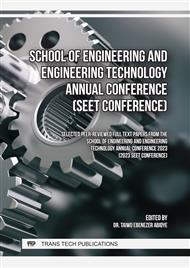p.3
p.13
p.33
p.41
p.49
p.59
p.67
p.73
Friction Extrusion Spot Welding of Aluminium Alloy: A Comparative Assessment of Top and Bottom Plate-Extrusion
Abstract:
This paper integrated two severe plastic deformation methods, namely frictional extrusion, and friction stir spot welding to obtain synergetic benefits and create a friction extrusion spot welding (FESW) process. The FESW process was carried out with the use of AA1xxx Al alloy by interchanging the location of the predrilled extrusion hole (between the upper and bottom plates). The microstructure, tensile-shear load, and fracture behaviours of the welds were investigated. The results revealed the presence of no weld discontinuities/flow-aided defects while the FESW process was effective in filling the extrusion holes irrespective of the location of the predrilled holes. An inverse relationship was found to ensue between the tool’s rotating speed and the tensile-shear load of the bottom plate hole-friction extrusion spot welded joint joints while a direct correlation occurred between the tensile-shear load and the rotational speed (up to 1100 rpm) in the top plate hole-friction extrusion spot welded joints. The difference in the tensile and fracture behaviours of the two weld categories is attributed to the disparity in the hole-filling mechanisms. The maximum tensile shear load of 3.1 kN (at 710 rpm) and 3.3 kN (at 1100 rpm) were obtained in the bottom plate hole-and top plate hole-FESW joints respectively.
Info:
Periodical:
Pages:
33-39
Citation:
Online since:
July 2024
Authors:
Price:
Сopyright:
© 2024 Trans Tech Publications Ltd. All Rights Reserved
Share:
Citation:


